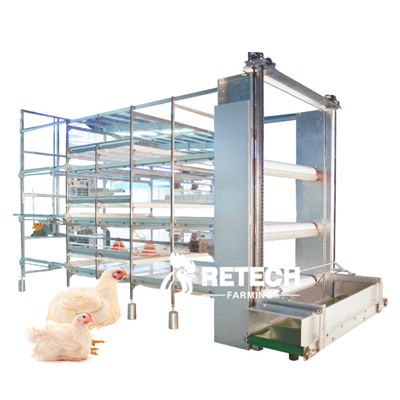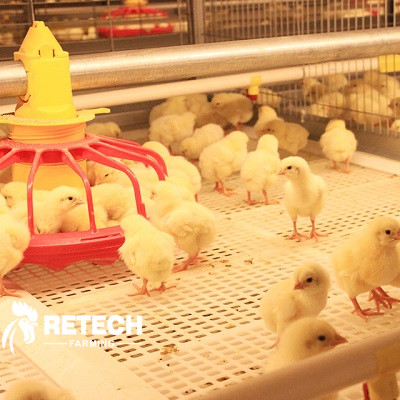Курыцыводам варта звярнуць увагу на наступныя аспекты:
1. Пасля апошняй партыібройлерныя курывызваляюцца, як мага хутчэй арганізуйце ўборку і дэзінфекцыю куратніка, каб забяспечыць сабе дастаткова вольнага часу.
2. Падсцілка павінна быць чыстай, сухой і гладкай. Адначасова яе трэба дэзінфікаваць.
3. Трымайце адну і тую ж партыю бройлерных куранят у адным куратніку, каб прадухіліць перакрыжаванае заражэнне хваробамі.
4. Павышайце тэмпературу як мінімум за 24 гадзіны да пачатку, каб тэмпература падсцілкі складала 32-35 градусаў.°C.
5. Незалежна ад таго, ці гэта падтрымка з пасцельнай бялізнай, ці падтрымка ў інтэрнэце, варта адстойваць усе намаганні.
6. Шчыльнасць: пры звычайных абставінах шчыльнасць пасадкі складае 8 галоў/квадратны метр, зімой яе можна павялічыць да 10 галоў/квадратны метр, а ў пачатку года — да 35 галоў/квадратны метр.бройлерныя куры наседжванне. Рэкамендуецца пашырыць групы 7-дзённых, 14-дзённых і 21-дзённых курэй адпаведна адзін раз.
7. Тэмпература: Паколькі сістэма тэрмарэгуляцыі ў бройлерных куранят яшчэ не цалкам развіта, неабходна прадугледзець сістэмы ацяплення для іх абагрэву. Асаблівую ўвагу варта звярнуць на тое, ці адпавядае паводзіны куранят тэмпературы ў памяшканні.
8. Асвятленне: Існуе мноства праграм асвятлення, якія называюць найбольш навуковымі. Мы павінны выбраць праграму асвятлення, якая нам падыходзіць.
9. Вільготнасць: Адносна высокая вільготнасць паветра павінна падтрымлівацца на працягу 1-2 тыдняў на ранняй стадыі, а адносна нізкая — з 3-тыднёвага ўзросту да забою. Рэкамендаваны стандарт: на працягу 1-2 тыдняў адносная вільготнасць паветра павінна кантралявацца на ўзроўні 65%-70%, а затым на ўзроўні 55%-60%, мінімум не менш за 40%.
10. Вентыляцыя: Пастаянна высокая канцэнтрацыя шкодных газаў (такіх як аміяк, серавадарод, чадны газ, вуглякіслы газ і пыл і г.д.) можа прывесці да анеміі ў курэй, аслаблення фізічнага стану, зніжэння прадукцыйнасці і ўстойлівасці да хвароб, а таксама да лёгка выкліканых рэспіраторных захворванняў і асцыту, што выклікае велізарныя страты ў вытворчасці бройлераў. Патрабаванні да вентыляцыі: бройлерам патрэбна добрая вентыляцыя на працягу ўсяго цыклу размнажэння, асабліва ў позні перыяд вырошчвання.
Спосаб кіравання:бройлерныя курыНа працягу першых 3 дзён выкормлівання курэй пакой зачыняюць, а верхнюю вентыляцыйную адтуліну можна адкрыць пазней. Улетку і восенню адчыняйце дзверы і вокны ў залежнасці ад тэмпературы на вуліцы, але не дапускайце прамога патоку халоднага паветра на птушанят; падніміце тэмпературу ў памяшканні на 2-3 градусы.°C перад праветрываннем у халодную пару года, а таксама выкарыстоўвайце поўдзень і другую палову дня, калі тэмпература на вуліцы высокая, каб належным чынам адкрыць акно сонцу для вентыляцыі.
Пытанні, якія патрабуюць увагі: неабходна строга прадухіляць атручванне газам; па меры паступовага павелічэння вагі бройлераў аб'ём вентыляцыі таксама павінен павялічвацца; аб'ём вентыляцыі павінен быць максімальна павялічаны пры ўмове забеспячэння тэмпературы; строга прадухіляць пранікненне злодзеяў.
11. Выбар корму: Кошт корму складае каля 70% ад кошту ўсяго бройлера. Выбар корму непасрэдна звязаны з эканамічнымі выгадамі ад вырошчвання бройлераў. Асноўная праблема заключаецца ў тым, які корм лепш за ўсё падыходзіць для кармлення, і вы можаце правесці некалькі параўнальных эксперыментаў адносна таго, які корм выкарыстоўваць.
12. Кіраванне ад перыяду вырошчвання да перыяду забою: Асноўная мэта вырошчвання падчас перыяду вырошчвання і забою — вытворчасць максімальнай колькасці курэй, якія адпавядаюць патрабаванням да прадукцыі пры разумным спажыванні корму. Адной з найбольш важных праблем у кіраванні гэтым перыядам з'яўляецца належны кантроль прыросту вагі і зніжэнне гібелі.бройлерныя курывыклікана празмерным ростам у пазнейшы перыяд. Для бройлераў з большай масай цела на пачатку вырошчвання неабходна адпаведна знізіць масу цела, каб дасягнуць чаканай прадукцыйнасці.
13. Меры засцярогі пры імунізацыі: метад імунізацыі бройлерных курэй часта грэбуюць, і хваробы схільныя да ўзнікнення на позніх стадыях. Таму рэкамендуецца ўводзіць жывыя вакцыны ў выглядзе вочных кропель, назальных кропель, спрэю і імунізацыі з дапамогай пітной вады.
Час публікацыі: 16 мая 2022 г.









